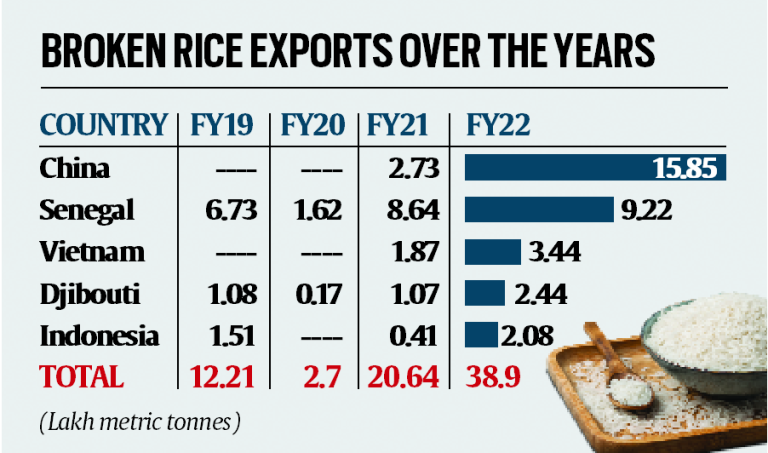Indian Economy
Ban on Exports of Broken Rice
- 12 Sep 2022
- 4 min read
For Prelims: Broken rice, Export Ban
For Mains: Government Policies & Interventions, Food Security
Why in News?
Recently, India has banned exports of broken rice and imposed a 20% duty on exports of non-Basmati rice except for parboiled rice to boost domestic supplies amid a fall in area under the paddy crop in the current Kharif season.
- India is the world's biggest exporter of rice which accounts for more than 40% of global rice shipments and it competes with Thailand, Vietnam, Pakistan, and Myanmar in the world market.
What is the Significance of Broken Rice?
- It is often used in the manufacture of feed for very young animals and for pets. Further, it is used for all types of livestock and is particularly suitable due to its rich caloric value and low fibre content.
- It is also used in the brewing industry, where it is mixed with barley and the production of arak (aniseed alcoholic drink, distilled, colourless drink).
- It is a raw material for rice flour, used in baby food, breakfast cereals, rice wine, rice liqueur, sake, and prepackaged and canned foods.
Why did the Government Ban the Export?
- Unusual rise in Exports: The broken rice exports have increased 42 times to 21.31 lakh metric tonnes (LMT) during April-August 2022 as compared to 0.51 LMT during the corresponding period of 2019.
- China was the top buyer (15.85 LMT) of Indian broken rice in 2021-22.
- Paucity in Domestic Market: Broken rice is also not available either for poultry feed or for ethanol for which they were using broken rice or damaged foodgrains.
- Rise in Global Demand: There has been a rise in global demand for broken rice due to a geo-political scenario which has impacted price movement of commodities.
- Decline in Domestic Production: The likely shortfall in area and production of Paddy for the Kharif season 2022 is 6% approx.
- The total rice sowing during the current kharif season has been so far about 20 lakh hectares less as compared to the corresponding figure of the last year due to poor rains in some states.
- Rice production may fall by 10 million tonnes and in the worst case it can be 12 million tonnes.
UPSC Civil Services Examination Previous Year Question (PYQ)
Prelims
Q. According to India’s National Policy on Biofuels, which of the following can be used as raw materials for the production of biofuels? (2020)
- Cassava
- Damaged wheat grains
- Groundnut seeds
- Horse gram
- Rotten potatoes
- Sugar beet
Select the correct answer using the code given below:
(a) 1, 2, 5 and 6 only
(b) 1, 3, 4 and 6 only
(c) 2, 3, 4 and 5 only
(d) 1, 2, 3, 4, 5 and 6
Ans: (a)
Exp:
- The National Policy on Biofuels, 2018, allows production of ethanol from damaged food grains like wheat, broken rice, etc., which are unfit for human consumption.
- The Policy also allows conversion of surplus quantities of food grains to ethanol, based on the approval of the National Biofuel Coordination Committee.
- The Policy expands the scope of raw material for ethanol production by allowing use of sugarcane juice, sugar containing materials like sugar beet, sweet sorghum, starch containing materials like corn, cassava, damaged food grains like wheat, broken rice, rotten potatoes, unfit for human consumption for ethanol production. Hence, 1, 2, 5 and 6 are correct. Therefore, option (a) is the correct answer






-min.jpg)